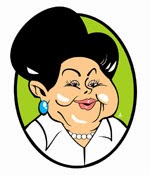Those were the days in the 1930s when life on the island moved in cadence with the gleeful exuberance halfway around the globe in pre-World War 2 America. This carried on through the years, all the way to the early 1970s with only a disruption during the ravages of the Japanese occupation in the 1940s.
Even today, it is hard to come by an occasion when strangers in Manila would introduce each other in a either a social or business setting wherein when a Negrense intoduces himself as having come from the sock-shaped island, that at least one other person in the conversation would raise an eyebrow. It always happens.
Despite these stories, most of them fabled yet somewhat strangely not too distant from the truth, there really was a time when Negros Island became poor. In the cycle of sugar planting, there are two seasons in a year - tiempo muerto (dead season while waiting for the cane to reach maturity), and tiempo galing (milling season when there’s money for everyone due to the agricultural activity). This time, it was totally tiempo muerto. World prices for sugar had fallen and the industry was besieged to an oppressive environment under martial law. Negros island’s land lay fallow, with hardly anything planted on tens of thousands of hectares.
The Dead Season seemed the end of the happy-go-lucky days.
In reaction to this extended tiempo muerto, a strange thing happened. The Negros doñas often referred to as "Inday" when referred to by the hired help, gave birth to a movement which brought out the best of Negros Island.
Wives of hacenderos came to Manila, grit their teeth, and learned the rudiments of handicraft-making, quality innovation and design from institutions such as CITEM (Center for International Trade Expositions and Missions), the Department of Trade and Industry, and the Design Center.
Returning to Negros, the Indays worked side by side with farmers’ wives, teaching them how to fashion trays, bags, place mats and other clever items from indigenous material. Leaves, twigs, barks, grass, bamboo, all became source material.
Overnight, spare space within the large homes of these ladies became workshops in the egalitarian effort to create econmic sustenance for those displaced by the downturn in sugar farming.
From those literal homegrown production lines, the wares produced were brought to Manila at the Ayala carpark behind the Intercon Hotel in 1985 in what was heralded as the first Negros Trade Fair. The ladies themselves were the tinderas (salesgirls).
 |
| Politicians and businessmen alike look forward to the annual return of the Negros Trade Fair to Makati |
What started as an all-female group, the Association of Negros Producers (ANP), a nonstock, nonprofit group, and the driving force behind the past 29 Negros Trade Fairs, has proven that there was providence in the season of poverty in the Island. The movement now provides alternative work for thousands of workers who once had to only depend on sugar farming as a means of income.
Today, ANP’s 85 members includes a multipurpose cooperative offering opportunities not only to farmers’ wives, but also to out-of-school youth, and the unemployed. Members can be offered enterprise loans (P150,000 tops) and training, marketing and consultancy services to micro- and small-scale enterprises.
Oh, the providence of poverty. The silver lining in the midst of the storm.
Yes, there was a time when Negros Island became poor. The nice thing about it is that it brought out the deeper riches of Negros Island. No, not sugar. Hope, determination, vision, perseverance, camaraderie, and most of all, equality.















